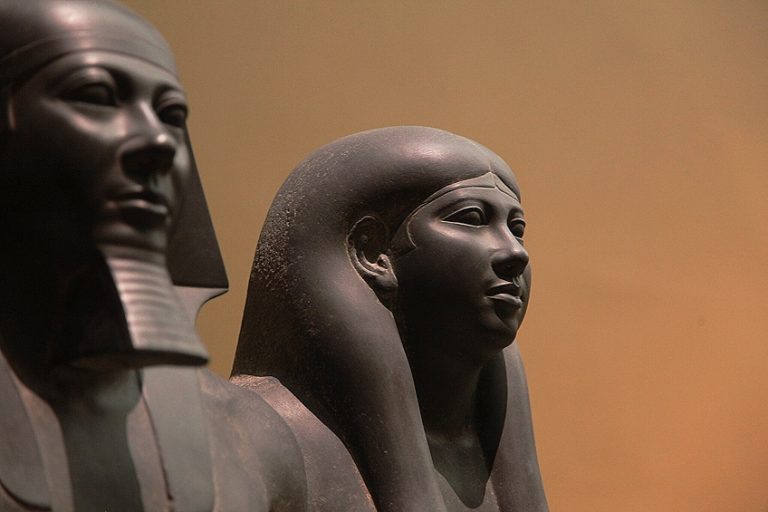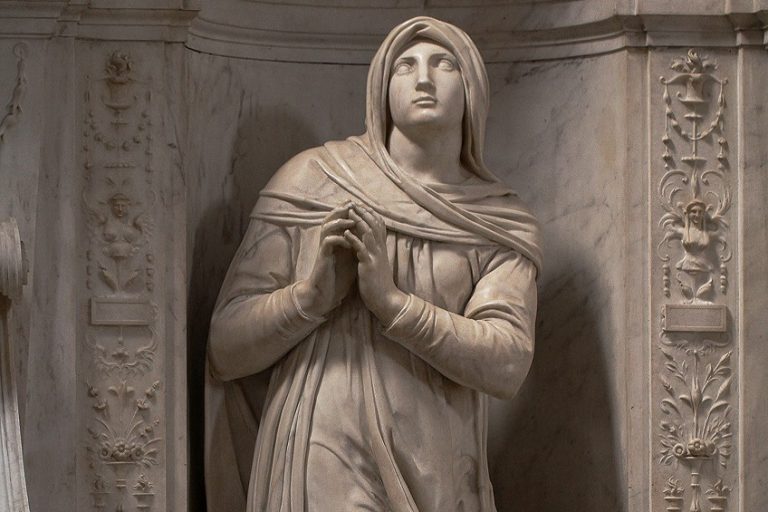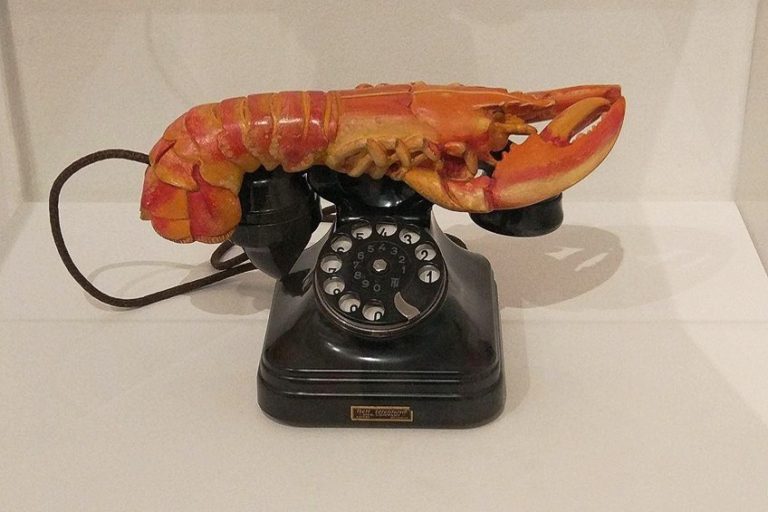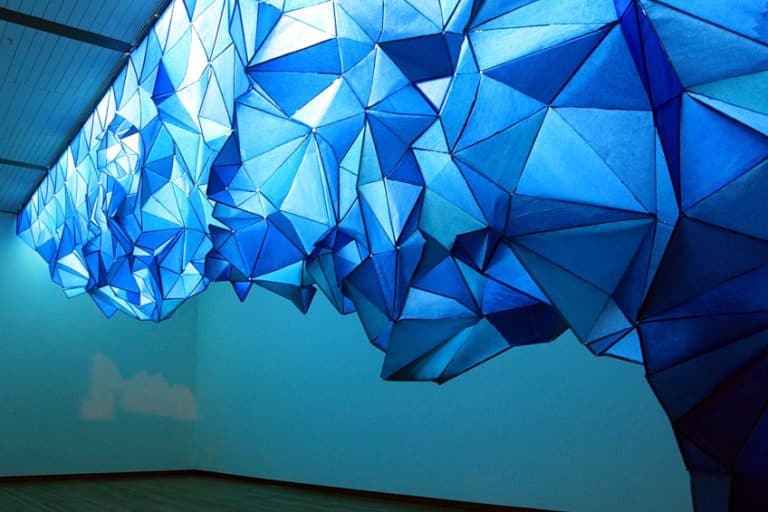Terracotta Warriors From the Mausoleum of the First Qin Emperor
Sometimes considered the eighth wonder of the world, the Terracotta Warriors from the mausoleum of the first Qin Emperor are some of the most magnificent historical artifacts known to date. This army of Terracotta Soldiers is shrouded in mystery and wonder, both for its rich history and artistic brilliance. But what are the secrets behind these clay warriors?
Terracotta Warriors From the Mausoleum of the First Qin Emperor
It is unlikely that you have never seen or heard of the Terracotta Army, or at least one of its many soldiers. After becoming a UNESCO heritage site in 1987, the Terracotta Soldiers have become almost synonymous with archaeology and ancient art itself, and are cherished not only in China but widely across the globe.

This article serves to complete your knowledge about these famous statues, and answer questions like why were the Terracotta Soldiers created, what they consist of, how they were found, and how they live on in the present day. As you will come to see, the story behind the Terracotta Warriors from the mausoleum of the first Qin Emperor is quite a magical one.
What or Who Were the Terracotta Warriors?
| Artist | Ancient Chinese artisans and craftsmen |
| Date Created | 246 – 210 BCE |
| Materials Used | Terracotta, bronze |
| Dimensions (m) | Pit 1: 230 x 62 |
| Art Movement | Qin Dynasty |
Near Mount Li on the outskirts of the city of Xi’an, China, lies a sacred tomb. In this tomb, an army of 8,000 intimidating clay soldiers stands guard, defending the resting place of their emperor. These are the Terracotta Warriors from the mausoleum of the first Qin emperor, Qin Shi Huang. Their number does not even include the chariots and horses that accompany these soldiers, alongside various other realistic terracotta sculptures.
These sculptures hail from as far back as 250 BCE, and are known for their lifelike appearance and precise level of detail, taking around 40 years to produce. Even though there are so many of them, each soldier has unique features, either in their facial designs, their costumes, or their poses. Ancient Chinese sculptors achieved this by working from ten main soldier models, and thereafter adding unique elements as they saw fit, bringing some personal artistic visions into the mix.
From their mustaches to their earlobes, these Terracotta Warriors appear individually distinct.
The soldiers occupy different ranks, evidenced by their uniforms and the ages portrayed in their faces. Each face hosts an emotion, either of excitement or somber contemplation, but all look ready for battle. In an effort to symbolize unified China, the soldiers are so detailed that their home region can be deduced by their facial features. Today, the soldiers appear gray in color, but research has revealed that their original paints included bright green, red, blue, white, and Han purple – a shade unique to ancient China made from barium.
As you might have picked up on, the main material used to create these statue soldiers was terracotta. Terracotta is a unique ceramic known for its reddish hues and hollow shaping, and was very popular among artists in the ancient world. The Terracotta Army was produced by molding terracotta around coils, and attaching separate body parts while balancing the statue’s weight. The Terracotta Soldiers are additionally decorated with materials such as geometric patterns and bronze ornaments.
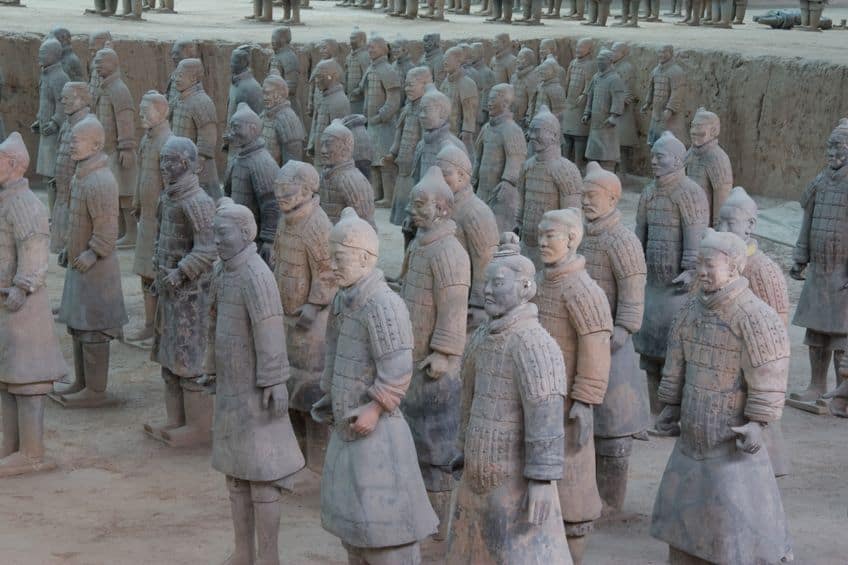
The Terracotta Warriors from the mausoleum of the first Qin Emperor originate from the tomb of the first Emperor of China, Qin Shi Huang. Qin is one of China’s most important historical figures, spearheading the eponymous Qin Chinese dynasty. The sheer size and number of the soldiers, along with the detail attributed to each one of them, are only one example of the critical influence held by Emperor Qin Shi Huang. This is all unpacked in the next section, which considers the history behind the Terracotta Soldiers.
Although the tomb consists of wooden frames and bronze decorations, the main working materials in the production of this massive tomb, and the Terracotta Warriors included, was dirt and clay. Other materials were prone to decay and water damage, whereas clay was strong yet moldable. There was also a lot of natural yellow clay in the area Qin Shi Huang designated for his tomb. To build walls and corridors, builders used a mix of clay, sand, and gravel packed tightly and made solid by drying.
It is important to clarify what we mean by tomb though, as Emperor Qin Shi Huang’s was far from your average ancient mausoleum.
In fact, the first Emperor of China’s tomb is more like a city or necropolis, with different streets, buildings, and monuments. It spans 57 kilometers squared and more parts of it are still being uncovered today, which comes as great news to art and history lovers like ourselves. The floors alone consist of over 250,000 bricks and the necropolis was designed as a replica of Xianyang, the capital city during the Qin Chinese Dynasty.
The History of the Terracotta Warriors
There are two stories packed into the broader history of the Terracotta Soldiers. One has to do with the way it was accidentally discovered, while the other has to do with how and why were the Terracotta Soldiers created.

Discovery
Most great ancient discoveries are made by professional explorers or archaeologists, with the required knowledge and with access to the best field sites. This was not the case when Qin Shi Huang’s tomb was discovered. Instead, it was stumbled upon by a group of local farmers looking to overcome a testing drought, unlocking a fragment of the past which had up to then been unknown for over 2,000 years.
The summer of 1974 was especially dry in China’s Shaanxi province. Like many farming families in the region, the Yang brothers knew that water was needed urgently. Led by the eldest, Yang Zhifa, the brothers undertook an amateur expedition in search of untapped water near Mount Li, which in other summers had sent rainwater down from its heights. With only hope and some shovels, the group dug away at the dry earth almost at random. Little did they know that they were standing just above one of history’s most remarkable discoveries.
Working away in the shadow of Mount Li for five days, the brothers’ shovels were eventually met with solid rock.
With some more digging, shards of broken pottery began to emerge from the earth. It had not been uncommon to find small, isolated artifacts or fragments in the Shaanxi region, and so the brothers continued to dig in the hope of establishing a well. Soon, however, they realized that these were not lost fragments but pieces of a full-bodied clay person, a Terracotta Soldier, to be specific!
A quiet frenzy soon followed. Villagers in the neighboring regions came to see the discovery up close, which also included bronze arrowheads found nearby the clay soldier. Some people collected these arrowheads to sell for scrap, while others simply theorized about who or what the terracotta sculpture was meant to represent. Overall, people were cautious about how to spread the news about the discovery, not knowing how the government may respond to the findings.

Despite many changes occurring in China at the time, archaeology remained highly appreciated and the government was interested in the findings at Mount Li. A local official dispatched to the site quickly recognized the value of the discovery and called in the museum curator of the nearest town. He dated the artifacts to the Qin Chinese Dynasty. Within a few weeks, professional archaeological teams descended on the site with a thirst for knowledge, knowing this may reveal lost information about China’s first emperor, Qin Shi Huang.
As stated above, these Terracotta Soldiers were housed in a massive tomb designed and constructed for the emperor. The archaeologists who first began professional expeditions at the site had no idea of this. Quite quickly into their dig, they realized that these were not just a few soldiers, but an army; not just a hidden gravesite but an entire city. It took more than half a year for these archaeologists to find the edges of the elaborate mausoleum of the first Qin emperor.
Production
We now know how these warriors were accidentally and yet fortunately discovered, but why were the Terracotta Soldiers created in the first place? There are a number of reasons, ranging from spiritual to political, but they all revolve around Emperor Qin Shi Huang’s influential and lasting leadership. The production history of the Terracotta Soldiers also involves the many artisans and laborers who exerted great effort to construct both the clay figures and the emperor of China’s large and complex tomb.
Appreciation for the afterlife was a belief shared by many ancient cultures around the world, and this was the case in China as well. It was a common practice to bury individuals with items that they used or cherished in the real world, ranging from clothes to artworks and musical instruments. These items could be made use of by the deceased in the afterlife.
Wealthy or influential families often sought to protect their deceased loved ones by leaving weapons or statues of soldiers in their tombs – Qin Shi Huang’s mausoleum is the foremost example of this practice. The Terracotta Army stands facing the east, defending the emperor’s resting place from the direction enemies were most likely to attack from.
But emperor Qin Shi Huang had always strived for immortality anyhow. During his reign, he often asked his scientists and philosophers to find ways of prolonging his life. It is likely that he foresaw a turbulent and divided China in his absence, and wanted to continue his stable rule. Indeed, the emperor was justified in his desire for immortality – he was the first to unify China.
Qin Shi Huang achieved unification by replacing the older feudal system with an organized government, and by promoting the idea of the nation working together as one. He also introduced a standardized system of writing and measurement, which increased China’s trading and administrative power. Like another one of his projects, the Great Wall of China, he wanted to stand against the test of time. As a political project as well, the mausoleum solidified Qin Shi Huang’s influence and his disciplined, legalist philosophy.
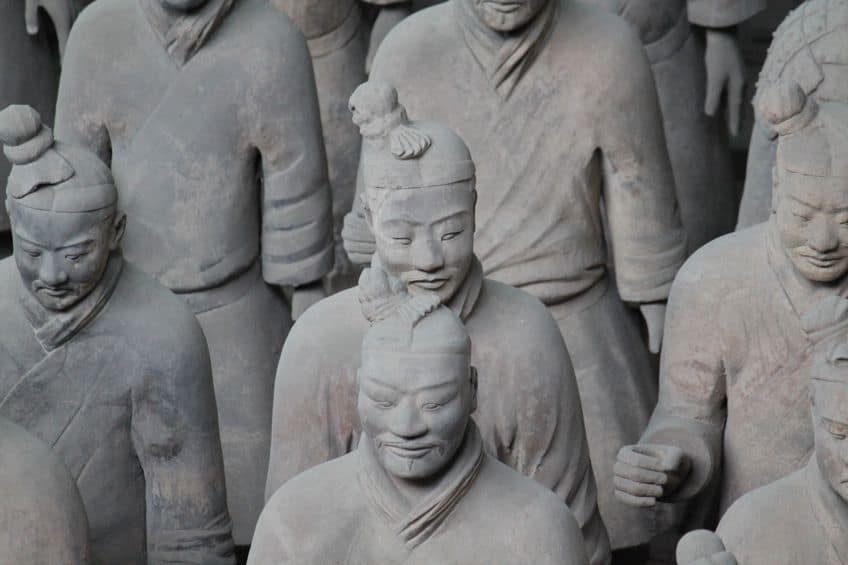
Work on the emperor’s city for the afterlife began in 246 BCE, some 40 years before his death. Over 700,000 people from all regions of China toiled away at this project, producing some of the most magnificent pieces of art known to us today. A number of historians suggest that some workers may have come from as far as Eurasia to work on the tomb, either as laborers or exchanged prisoners.
The Terracotta Soldiers are also some of the purest works of art, in the sense that they were never meant to be seen by people after the tomb had been sealed. All the effort truly was directed toward the afterlife – the Terracotta Soldiers were even given real, functional weapons! These have since been removed and stored for safety and preservation.
Historians remain perplexed about how a project of this magnitude was possible at this point in history, especially since archaeologists have found little evidence of workshops near the site.
The transport of materials, sculptures, people, and resources posed an enormous organizational challenge, but one which seems to have been met. The thickness of the Terracotta Soldiers’ molds also reveals that sculptors had masterful control over temperature for firing and cooling, initially thought to be unprecedented for this time period.
Historians have thus suggested that the mausoleum of the first Qin emperor was produced by making use of an early instance of an assembly line, with highly organized units working on different parts of the project simultaneously. Out of all of these workers, only around 1500 were permitted to build the statues. These were either established artisans or upcoming craftsmen. We know this because these artists left their names on the soldiers they sculpted, not only to be remembered but as a measure of quality control in a highly efficient system of production.
These artisans upheld realism as their key artistic vision. Realistic portrayals of individuals, buildings, and animals were as fresh as the Qin Dynasty itself. Before Qin Shi Huang’s ascension to the emperor of China, Chinese art was characterized by decorative or romanticized elements. The realism of the Qin period was also influenced by the belief in the afterlife, wherein realistic figures and objects were believed to have an important role to play.

There are more than just soldiers in the mausoleum too. Like a real city, archaeologists have found statues of acrobats, musicians, public officials, and even animals within its depths. What this tells us is that Emperor Qin Shi Huang not only sought protection in his afterlife but also enjoyment. These other sculptures are also portrayed in ultra-realistic form. One only needs to look at the flaring nostrils and decorated, flowing manes of the soldiers’ horses to understand the intensity of this realism.
The necropolis was not fully complete at the time of Qin Shi Huang’s unexpected death in 210 BCE, the result of a mysterious illness suffered on a tour of the nation that year. As the emperor of China had feared, the country was soon overcome with conflict and division after one of his closest advisers conspired to take power by granting the empire to the weakest of Huang’s heirs. The Qin Dynasty was displaced within only 15 years, but the sweeping changes left behind by Qin Shi Huang would continue to shape Chinese history into the present. After a few hundred years of power battles, the secrets of the first emperor of China and the Qin Chinese Dynasty slowly became lost to history, much like the tomb complex and Terracotta Soldiers as well.
We are fortunate that they were discovered, not only for their artistic worth, but as a complete understanding of Chinese history would have been unattainable without them.
The Terracotta Warriors Today
Today, the Terracotta Soldiers are housed at the Qin Museum of the Terracotta Warriors and Horses, just outside of Xi’an city. Because of the vastness of the discovery, it was decided that a museum should be built at the site of the findings, instead of attempting to move the artifacts elsewhere. Four main pits are visible at the site, all of which host Terracotta Soldiers, chariots, palace corridors, and a command tower. There are nonetheless hundreds of discovered and undiscovered pits, some empty, others full of priceless artifacts and rich histories.
Much has taken place here since that fateful day in 1974 when a few brothers looking for water instead found the past. The Yang brothers got jobs signing books for tourists at the museum and retelling their stories. The Yang family farm was enveloped by the museum complex, and they were granted land in a nearby village. Some of the brothers have raised some concerns about their recognition and rewards as discoverers over the years, however.

As one of the most famous tourist sites in both China and the world, accommodating over 5 million visitors per year, the Terracotta Soldiers have predictably been involved in a number of strange interactions with humans. While it is known that the tomb was looted in the years following Qin Shi Huang’s death, an attempt to steal and sell a soldier’s head in 1985 quickly became an example of why not to. In 2006, a German student once jumped into the pit and disguised himself as a statue among the rows of Terracotta Soldiers. He was successful, for several minutes at least, and faithfully refused to break character after being found. He was picked up and carried out by guards just like a statue would be.
Since their discovery, the Terracotta Soldiers have been tested by the forces of time. The statues, artifacts, and infrastructure that make up the necropolis are highly delicate and sensitive to the slightest of changes in heat or light. Air flows are carefully controlled in the museum after it was discovered that paint was disappearing due to the water in the original lacquer. In the 90s, it was also revealed that the breath of visitors mixed with damp air was contributing to fungal growth in the pits. Ever since, non-corrosive fungicides have been in use.
As mentioned, much still stands to be discovered in the Mausoleum of the first Qin Emperor.
Estimates suggest that only a quarter of the Terracotta Army has been uncovered, let alone the entire tomb complex. In light of the challenges of preservation mentioned above, the actual tomb of Qin Shi Huang has never been opened. It is said that only a few seconds of open air could tarnish the artifacts locked behind the doors of the tomb. We have also seen enough adventure movies to know that disturbing the tomb of this great ruler might not be the best idea.
Major findings continue to be excavated from the site today. Throughout the 2010s, another palace and around 200 more soldiers were discovered near the main pits, with some of the latter group soon after being added to the main Terracotta Army. Plans are in place for the Lishan Garden, which will host the other lifelike sculptures that populate the tomb complex, like acrobats and political officials. The Terracotta Soldiers also travel the world, although in small groups, as they are displayed consistently in temporary exhibitions at museums all over the globe.

The Terracotta Soldiers are but one part of a larger monument, a city, in fact, designed to accommodate China’s venerable first emperor Qin Shi Huang in his afterlife. They are nonetheless mesmerizing pieces of art, able to be appreciated by just about anybody willing to take a look. It is actually more difficult to not appreciate the Terracotta Soldiers – they embody advanced levels of artistic skill, but also have a personality and liveliness that remains unachievable by some of the most modern artworks. It is all the more shocking that we only became aware of their existence less than 50 years ago.
Take a look at our Terracotta Warriors webstory here!
Frequently Asked Questions
Who Made the Terracotta Soldiers?
The Terracotta Army, along with the mausoleum of the first Qin emperor, was produced by a diverse workforce of over 700,000 artisans, craftsmen, builders, calligraphers, and other workers hailing from different regions of China. Grave findings suggest Eurasian workers may have also been sourced.
What Do the Terracotta Soldiers Symbolize?
The Terracotta Soldiers all together form a replica army purposed with defending emperor Qin Shi Huang in his afterlife. The soldiers face the east, towards where the emperor’s enemies were most likely to attack from. Each soldier is designed to appear completely unique, like an army in real life.
How Many Terracotta Soldiers Are There?
As of 2022, roughly 8,300 Terracotta Warriors have been discovered, although not all have been made visible to the public. Archaeologists estimate that only a quarter of the army has been recovered thus far. This number does not include the statues of animals and other individuals also found in the tomb.
Armin Kific is a social and political researcher and writer based in Pretoria, South Africa. He completed a degree in Political Science with majors in History and Philosophy in 2020 and has since completed an Honours in Anthropology and History. He is also currently pursuing a Master’s degree in Social Sciences from the University of Pretoria. Armin’s knowledge of the arts spans various mediums, and he is always looking for ways to marry art with social science. In 2021, he produced a short documentary film about the often-forgotten South African soul star Mpharanyana, integrating history, music, photography, and film. Armin is well-versed in art history, especially in the fields of political artwork and ancient artifacts. He enjoys exploring art history sources for information that has been lost or overlooked. He is also trained in biographical writing.
His favorite art movements include baroque, surrealism, and neoplasticism. Armin is an ardent supporter of indigenous art in South Africa and is involved in an organization that looks to uplift South African artists following the challenges of Covid-19. By writing for ArtInContext, Armin continues to cultivate his artistic creativities and unite perspectives between art and society.
Armin has been working for artincontext.org as an author and content writer since 2022. He writes about the topics of art history, specializing in political artworks and ancient artifacts.
Learn more about Armin Kific and the Art in Context Team.
Cite this Article
Armin, Kific, “Terracotta Warriors From the Mausoleum of the First Qin Emperor.” Art in Context. February 20, 2023. URL: https://artincontext.org/terracotta-warriors-from-the-mausoleum-of-the-first-qin-emperor/
Kific, A. (2023, 20 February). Terracotta Warriors From the Mausoleum of the First Qin Emperor. Art in Context. https://artincontext.org/terracotta-warriors-from-the-mausoleum-of-the-first-qin-emperor/
Kific, Armin. “Terracotta Warriors From the Mausoleum of the First Qin Emperor.” Art in Context, February 20, 2023. https://artincontext.org/terracotta-warriors-from-the-mausoleum-of-the-first-qin-emperor/.



